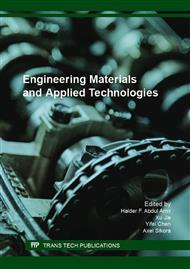p.3
p.9
p.14
p.20
p.25
p.30
p.37
p.42
Nano-Scale Particle Formation by Dynamic Mixing Method in Physical Vapor Deposition
Abstract:
Nano size (2 - 10 nm) metal particles were formed and accumulated on powder substrate by conventional physical vapor deposition (PVD) process, in which the powder were a non-volatile in vacuum, such as Al2O3 powder. The neutral nuclei which were formed on the substrates from vaporized or sputtered metal atoms at an initial thin film growth were not grown up to coalescence and island stage with arrival atoms and ad-atom migration in the continuous deposition process, when the powder in vessel were continuously stirred during the deposition. Nano sized particles on the polymer chips (diameter: 1-2mm) easily dispersed into the polymer matrix by heating the chips, and on non-soluble powder, g-Al2O3, were stuck on the supporters stably in air. The nanoparticles on sucrose directly formed colloid with water solvents without dispersive agents. Most of the nano sized particles appear their own characteristic colors due to plasmon effect. Concentration and size of the nanoparticles are controlled by physical parameters in the PVD and the stirring speed of the powder. Surface phenomena on the substrate have been discussed with TEM, SEM, EDX, UV spectroscopy, etc. comparing with the conventional thin film growth.
Info:
Periodical:
Pages:
14-19
Citation:
Online since:
September 2016
Authors:
Keywords:
Price:
Сopyright:
© 2016 Trans Tech Publications Ltd. All Rights Reserved
Share:
Citation:


